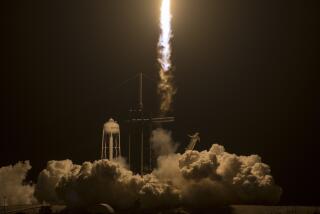Launch Is Marred by Cooling System Worries
- Share via
CAPE CANAVERAL, Fla. — The veteran shuttle Columbia rocketed into orbit Friday and set off after the Hubble Space Telescope for a five-spacewalk overhaul and upgrade, the most complex orbital service call ever attempted.
But Columbia’s picture-perfect launch was clouded by a potentially serious problem with the ship’s cooling system that could, in a worst-case scenario, force NASA to forego the long-planned Hubble repairs and instead bring the shuttle back to Earth ahead of schedule.
After studying telemetry from the shuttle in more detail, however, mission managers decided late Friday to continue the flight as planned, pending the results of additional overnight analysis. Engineers expect those results to clear Columbia for a full-duration mission.
“Our initial looks at the system show it to be stable, even with the degradation, and we believe we are safe to continue on orbit for the next 24 hours while we continue to look at further information and to refine our analysis,” program manager Ronald Dittemore said.
“This analysis, we firmly believe, will conclude we are safe to continue the mission for the full duration. We just need the time to make sure we dot all the i’s and cross all the t’s to be positive about that.”
Fresh from a 2 1/2-year, $100-million overhaul, NASA’s oldest shuttle roared to life at 6:22 a.m., putting on a spectacular predawn light show as it knifed through a low deck of clouds and arced away over the Atlantic Ocean.
Aboard were Cmdr. Scott Altman, rookie pilot Duane Carey, flight engineer Nancy Currie and spacewalkers John Grunsfeld, Richard Linnehan, James Newman and Michael Massimino, another first-time flier.
If all goes well, Altman will guide Columbia to a rendezvous with the 24,000-pound space observatory early Sunday. The first of five back-to-back spacewalks to upgrade and overhaul the $2-billion observatory will begin around 1:30 a.m. Monday.
The primary goal of the mission is to refurbish Hubble’s aging electrical system by installing two new solar arrays and a new power control unit, a 160-pound “black box” that routes electricity from the solar panels to the telescope’s instruments and subsystems.
While Columbia’s ascent Friday was virtually flawless, the coolant system problem prompted a scare in NASA’s flight control team.
The shuttle is equipped with two Freon-21 coolant loops to dissipate the heat generated by the ship’s myriad computers, avionics systems and other electrically powered equipment.
During launch and reentry, Freon in the two coolant loops sheds that heat in devices that cause water or ammonia to boil, depending on the shuttle’s altitude. During orbital operations, cooling is provided by radiators mounted on the inner surface of each payload bay door.
Just after Columbia reached orbit Friday--before the cargo doors were opened and the radiators were deployed--flight controllers noticed reduced flow in one of the coolant loops, apparently the result of some sort of blockage in a line.
The flow returned to normal once the cargo bay doors were opened and the radiators were deployed. But the reduced flow rate in coolant loop No. 1 presumably will show up again once the cargo bay doors are closed for reentry and the radiators are bypassed.
NASA flight rules require a minimum flow rate of 211 pounds of Freon-21 per hour to prevent critical systems from getting too hot. Should one loop be declared out of limits, the shuttle would be one failure away from potentially catastrophic overheating.
NASA’s conservative flight rules require a shuttle crew to break out of orbit and return to Earth at the first opportunity to reach a U.S. landing site if one of the coolant loops is declared inoperable.
But initial telemetry showed coolant loop No. 1, although close to the flight-rule redline, was within allowable limits and it was not getting worse. Mission managers are hopeful Columbia’s crew will be able to press ahead with a full-duration flight.
“We’re all hoping that we can rendezvous with the Hubble [on Sunday as planned] and fix it,” astronaut Steve MacLean radioed Columbia’s crew from mission control in Houston.
More to Read
Sign up for Essential California
The most important California stories and recommendations in your inbox every morning.
You may occasionally receive promotional content from the Los Angeles Times.













